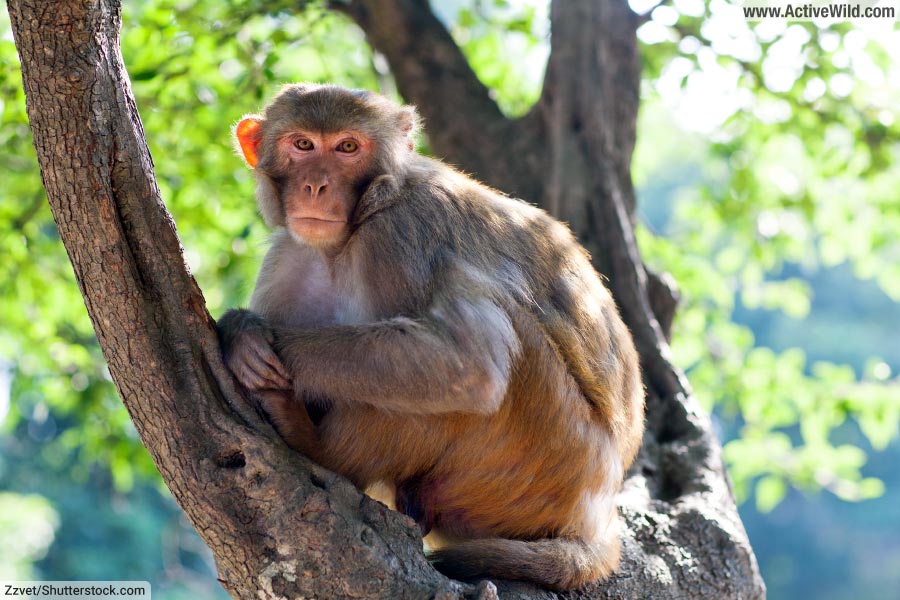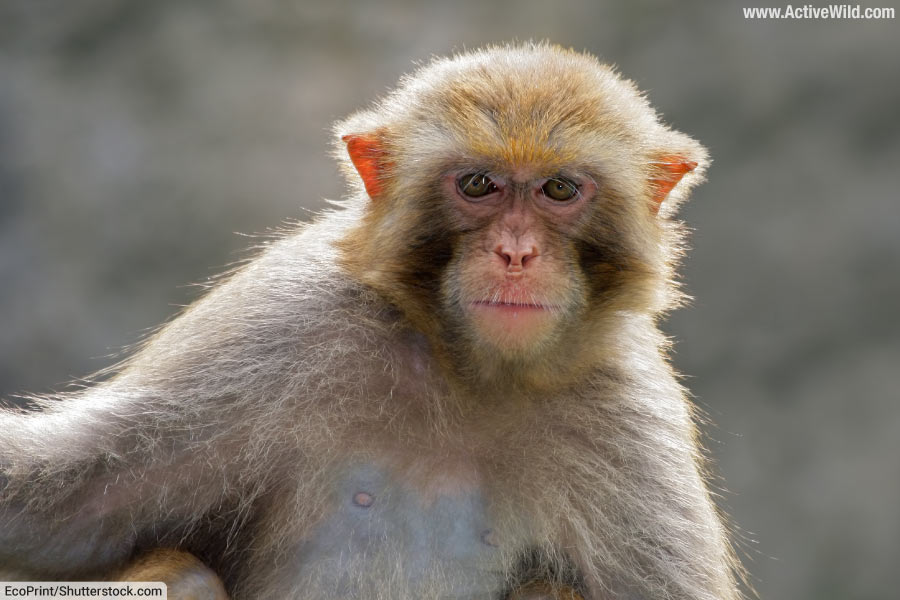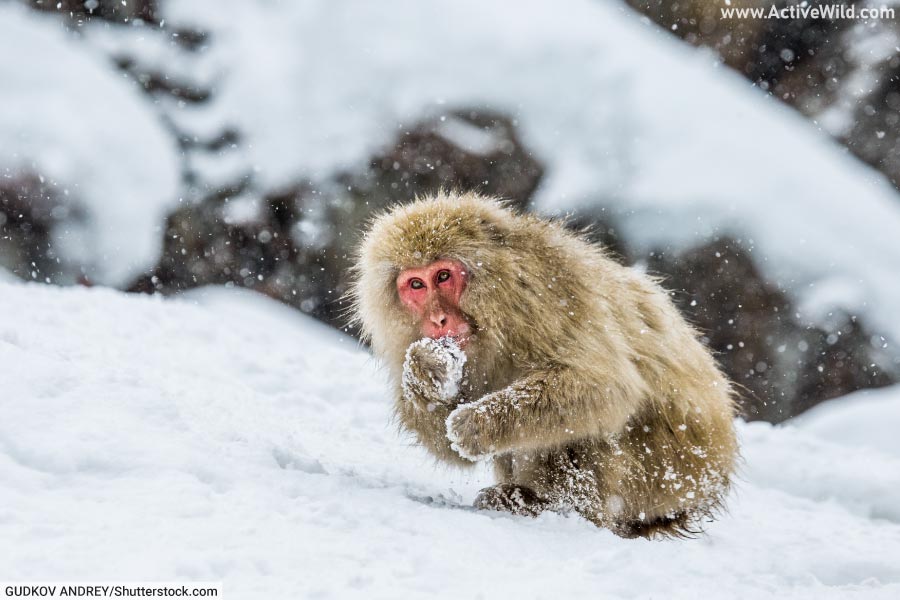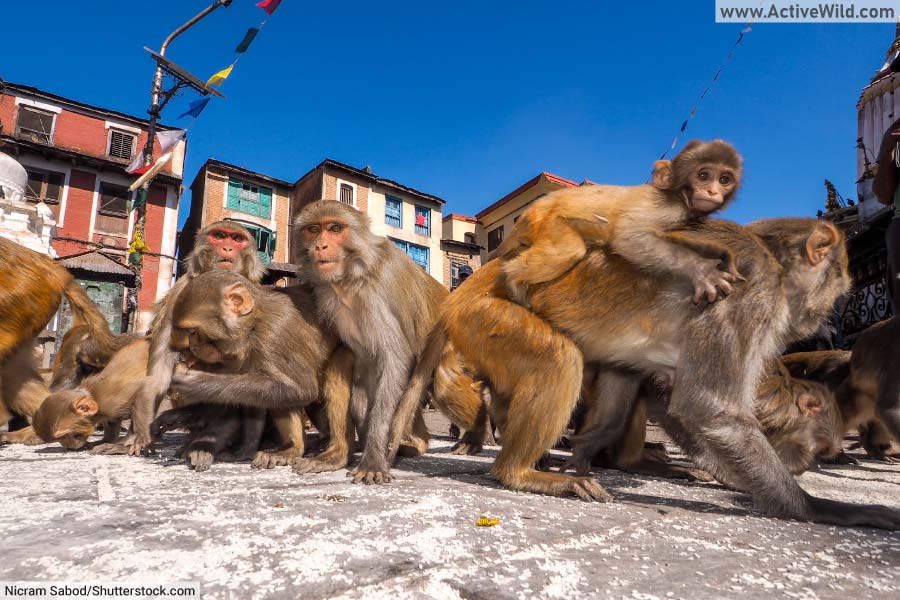The Rhesus macaque is a primate belonging to the Old World monkey family. Found in Asia, this common and wide-ranging species inhabits a larger area than any other non-human primate.
Page Index
- Rhesus Monkey Key Facts
- Introduction To The Rhesus Macaque
- Physical Description
- Rhesus Macaque Family And Related Species
- Macaques
- Range & Habitat
- Diet & Foraging
- Is The Rhesus Macaque Endangered?
Related Pages
- Discover more about primates: Primates - The Ultimate Guide
- Discover more about monkeys: Monkeys - The Ultimate Guide
- Discover other monkey species: Types of Monkeys
- Visit our main animal page: Animals - Complete Guide
Rhesus Macaque Key Facts

- Other name(s): Rhesus monkey
- Scientific Name: Macaca mulatta
- Order: Primates
- Family: Cercopithecidae
- Height: Approximately 0.5 meters (1.64 feet) tall when fully grown and standing
- Weight: Males typically weigh between 7.7-11.7 kg (17-26 lb), while females typically weigh between 5.3-9.1 kg (12-20 lb)
- Where Found: native to South, Central, and Southeast Asia.
- Habitat: occupies a great diversity of altitudes and habitats, from grasslands to arid and forested areas, as well as human towns and cities.
- IUCN Conservation Status: Least Concern
Rhesus Monkey Fun Facts
- The rhesus macaque is found across a wider area than any other nonhuman primate.
- A rhesus macaque named Sam was sent to the edge of space in NASA’s Little Joe 2 spacecraft. After reaching an altitude of 55 miles, Sam returned to Earth and was recovered unharmed. He was one of several rhesus macaques to have been used in space flight research.
- The Rhesus factor, or Rh factor, of human blood is named after the rhesus macaque. Humans who have a particular antigen are referred to as Rh or rhesus positive, while those who lack it are Rh or rhesus negative. In the 1930s and 1940s, experiments conducted on rhesus monkeys led to the discovery of the Rhesus factor.
Rhesus Macaque

The Rhesus Macaque (Macaca mulatta) is a primate in the Old World monkey family, Cercopithecidae. It inhabits a broad range crossing South, Central, and Southeast Asia, making it the (nonhuman) primate with the widest geographic spread.
This adaptable species is able to thrive in a diverse range of habitats, including grasslands, forests, and arid regions.
The rhesus macaque is also often commonly found in towns and cities, including the Indian cities of Delhi, Jaipur, and Varanasi.
The rhesus macaque is highly social, living in groups with a clear hierarchical structure, and communication between individuals is complex and involves both vocalizations and physical gestures. The species is diurnal (active during the day), and spends time both on the ground and in trees.
The Rhesus Macaque often comes into conflict with humans due to its tendency to raid crops and inhabit urban areas. In some areas it is considered a pest due to its crop-raiding behavior, and in cities it can occasionally be aggressive towards humans.
Rhesus Macaques are often used as model organisms (organisms used in place of other organisms) in research, given their physiological and genetic similarity to humans. A number of crucial discoveries in medicine and psychology have been made as a result of studying the species.
Physical Description
The Rhesus Macaque (Macaca mulatta), also known as the rhesus monkey, is a medium-sized primate with a robust and agile body. It exhibits significant sexual dimorphism (difference between male and female) in its size, with males generally being larger and heavier than females.
On average, an adult male measures about 53 cm in length and weighs between 7.7-11.7 kg, while an adult female measures around 47 cm and weighs between 5.3-9.1 kg.
The color of the Rhesus Macaque's fur varies from light brown to grey, with a pink or light-brown face that is typically bereft of fur. The face is characterized by close-set, round eyes and a prominent muzzle. The arms and legs are of about equal length. The tail is medium in length and while not prehensile (able to grip) is often used for balance.
The Rhesus Macaque has a very expressive face, which is an important aspect of the species’ complex social interactions. Like most Old World monkeys, it has a dental formula of 2:1:2:3.
Rhesus Macaque Family And Related Species
The Rhesus Macaque is a member of the order Primates, and is part of the family Cercopithecidae, also known as the Old World monkeys.
The Old World monkey family is the largest of the primate families, containing over 138 species divided into 19 genera.
in addition to the 23 currently-recognized macaque species, the family is home to species such as baboons, mandrills, and colobus monkeys.
Macaques

Macaques are a diverse and adaptable group of Old World monkeys that make up the genus Macaca. Currently, 23 species of macaque are recognized. They are spread across Asia, North Africa, and (in one instance) Gibraltar.
Macaques are known for their intelligence and complex social structures, often living in large groups with clear hierarchies. Notable for their high adaptability, they can be found in a variety of habitats, ranging from snow-covered mountains to dense rainforests, and often thrive near human settlements.
Examples of macaques include: the bonnet macaque, the crab-eating macaque (also known as the long-tailed macaque), Tibetan macaque (the largest macaque), the Japanese macaque (also known as the snow monkey) and the Barbary macaque (the only monkey found in the wild in Europe).
Where Is The Rhesus Macaque Found? Range & Habitat

The Rhesus Macaque inhabits a broad range in South, Central, and Southeast Asia. No other primate other than humans is found across a wider area.
The species’ natural habitats are diverse and include grasslands, high mountains, and forests that span Afghanistan, Pakistan, India, Southeast Asia, and China.
The Rhesus Macaque is often seen in urban and suburban environments, living in close proximity to humans. In many Indian cities, for example, the monkey is a common sight in temples, parks, and even residential areas.
Indian cities in which the rhesus macaque is resident include Delhi, Jaipur, and Varanasi, among others.
The Rhesus Macaque has also been introduced to other parts of the world. A well-known colony resides in Silver Springs State Park in Florida, USA, after being introduced there in the 1930s. These monkeys have occasionally been sighted in the nearby urban areas.
What Does The Rhesus Monkey Eat? Diet & Foraging
Rhesus Macaques are omnivorous, possessing a flexible and diverse diet that allows them to thrive in a wide variety of habitats. They consume a range of foods including fruits, grass, leaves, roots, bark, and flowers, as well as insects, small animals and bird eggs.
The rhesus macaque has special cheek pouches in which it can store food for later consumption.
Soil eating (geophagy) is common among rhesus monkeys (source) – this may be to supplement the monkey’s mineral intake, or to aid digestion.
Researchers found that members of the introduced rhesus monkey colony in Florida’s Silver Springs State Park would consume eggs taken from bird nests. (source)
Is The Rhesus Macaque Endangered?
The Rhesus Macaque is not endangered. At the time of writing, the species’ IUCN conservation status is “Least Concern” (June 2023). This is due to the species' wide distribution, adaptability to a variety of habitats, and large population size.
Related Pages
Discover more about primates: Primates - The Ultimate Guide
Discover more about monkeys: Monkeys - The Ultimate Guide
Discover other monkey species: Types of Monkeys
Visit our main animal page: Animals - Complete Guide

